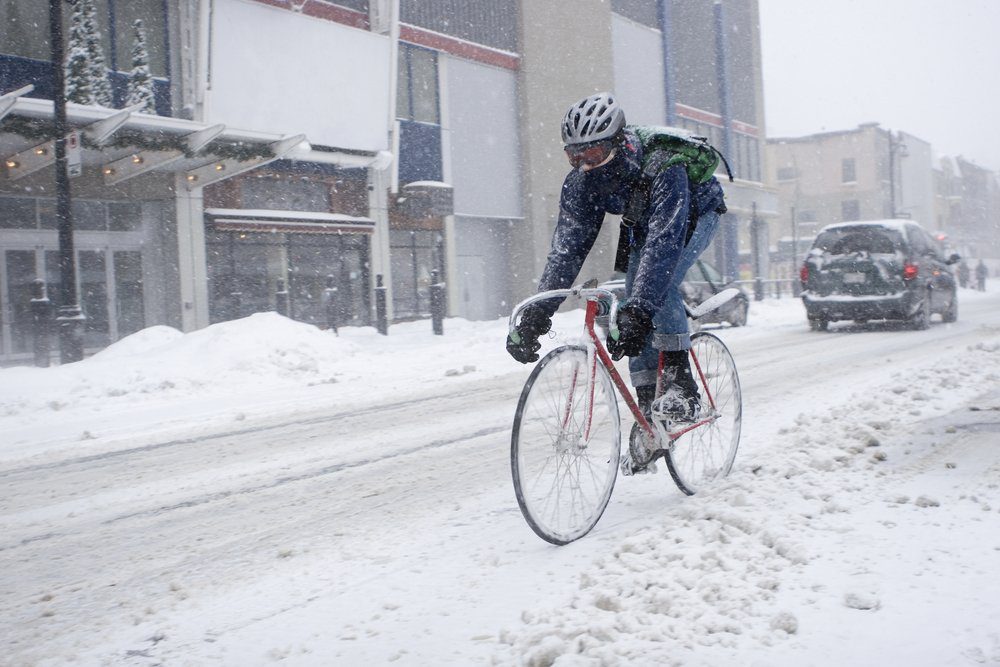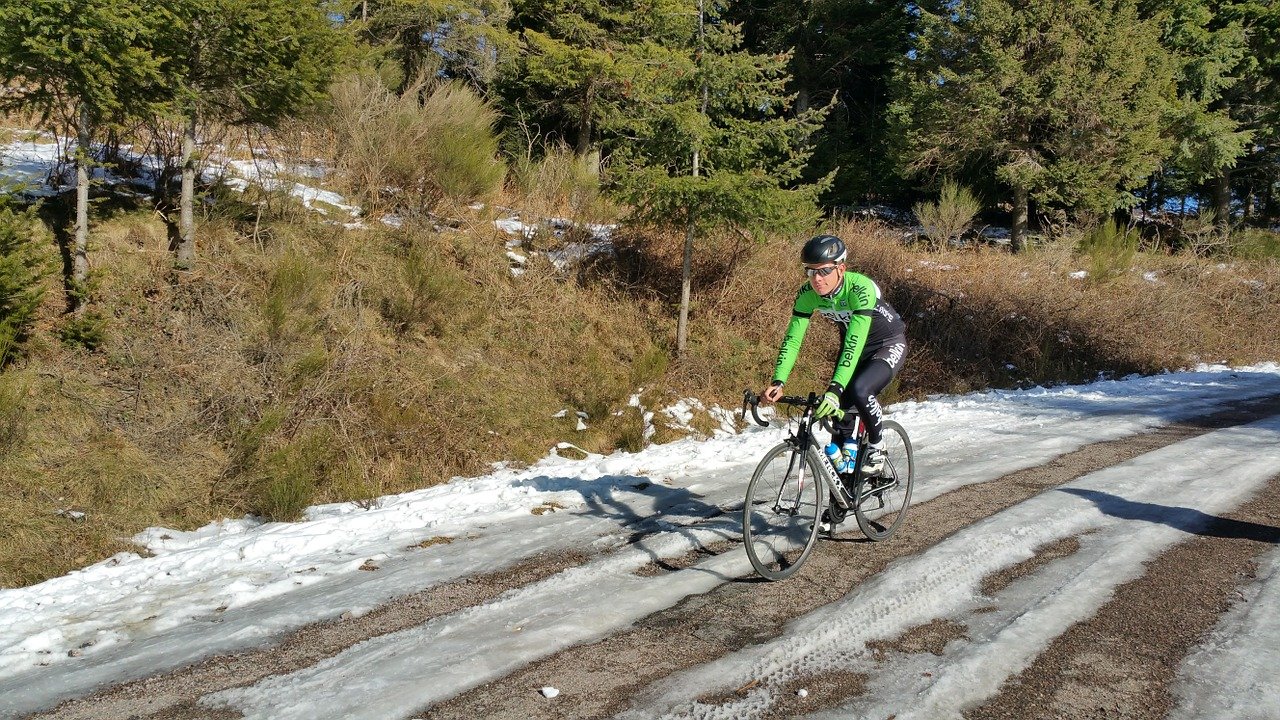Top Tips for Safe Winter Cycling

Winter cycling can be uncomfortable, and it can be treacherous. Many riders will think about the dangers of cycling on black ice or gritted roads and opt to stay home, training on turbos or rollers instead. But for all the challenges that come with winter cycling, it can be one of the most rewarding and beautiful times of the year to get out on your bike.
At the time of writing, we are in the midst of our third national Covid 19 lockdown and it more important than ever to stay safe if you choose to cycle outdoors when the weather permits. We take a look at some ways to stay safe when cycling outdoors in the winter months.
Preparing your bicycle for safe winter cycling
There are a few things you can do to get your bike winter-ready without having to spend a fortune.
Ideally, you want to swap your tires out for the fattest pair that will fit, and pump them up to the lowest pressure they will take. One benefit of running tubs is you can use a lower pressure without risking pinch flats, but you’ll get by with clinchers just fine. There is no reason to buy a whole new pair of wheels for the winter, unless you were looking for an excuse to do so anyway.
If you are looking to get a new winter bike or commuter, then a dedicated cyclocross bike is a great option. They are designed with space for knobbly tires, and most come with disc brakes which are a huge benefit when it gets icy. And if nothing else, it is an excuse to get into a new hobby.
Loved by hipsters and old school club riders, your other option is to go fixed gear. The direct drive to the back wheel lets you feel the road surface beneath the bike so you can react to slips and slides more easily. You can slow down without using the brakes, and the lack of freewheel will force you to maintain a more steady cadence, both of which help maintain traction on slippery surfaces.
The last tip that seems to come up all the time is swapping over to a pair of flat pedals when the temperature drops. The idea is it is easier to put your foot down to correct a problem when things get a bit wobbly.
In my limited mountain bike experience, I feel a lot more in control on slippy mud and roots when I’m using clipless pedals than I do on flats, so I suspect that is one to try and make your own mind up about.
As a courtesy to other riders, make sure you have proper mudguards fitted. The British winter means rain and slush much more often than it does ice and snow. Mudguards don’t look very stylish but the people you are riding with will very much appreciate it if you have them and don’t cover them in mud.

It’s OK to stay inside
If out riding in the winter, there is always a possibility of slipping on ice and in the current climate, now is not the time to end up in an ambulance waiting for an x-ray.
We should all be cycling within our local areas however, it’s more important than ever to pick your route carefully and beware of black ice. If the temperature dipped below freezing overnight, there is a good chance of ice on the roads the next morning. Check the previous night’s temperature online before you head out, and bear in mind that if you live in a city it is usually colder once you get out into the countryside. Quiet back roads are less likely to be gritted than busier roads with more traffic. While your usual ride may take you down an isolated and car-free country road, it might be best avoided if the temperature dropped below freezing overnight.
Normally we’d be out riding in groups, but the current Government advice is that you can meet one friend for exercise. Whether winter riding during Covid, or in “normal life”, give yourself a little more space.
Getting into cycling as a teenager, I was told if my front wheel wasn’t buzzing against the person in front’s rear, I wasn’t close enough. Usually the riders at the front of a bunch will see any hazards coming and provide plenty of warning to those behind. However, a patch of ice however might be completely invisible and there are plenty of examples where entire groups have gone down on the same corner after hitting black ice.
By giving yourself a bit more of a gap than usual, you can react to last-minute hand signals. If a rider hits black ice on a corner they can be down in an instant, and leaving space can mean the difference between avoiding the hazard yourself, or riding over the top of them.

Ice tends to form in all the areas most likely to cause problems for cyclists. Roads are designed so that moisture drains off from the centre towards the kerb, and during the day they warm up from the centre outwards. Because of this, it may be safer in icy conditions to take a primary position on the road and avoid the slippery surface closer to the edge. Ice also has a habit of forming at the bottom of descents (particularly in valley bottoms), at the lowest side of a cambered corner, and where water can run off adjacent fields onto the road. Bear in mind that it doesn’t need to have rained or snowed recently for ice to form either. A heavy fog will condense on the road surface when it gets cold and create a slippery layer.
Black ice is particularly dangerous as you can’t see it and once you’ve discovered you’re riding over it, braking and sudden movements will just make you slip and slide everywhere. You can read top tips on how to ride on black ice in this helpful article. Winter definitely isn’t the right time of year to be chasing a KOM unless you want to find yourself in a hedge.
If you are unsure if the road is icy or how to control your bike confidently on ice, there is nothing to stop you jumping off and pushing. You have already gained cycling kudos for heading out despite the cold, and no one is going to judge you for playing it safe. Be aware that difficult conditions for you can also mean difficult conditions for drivers, particularly those who aren’t confident on the roads when the mercury drops. Keep a wide berth of cars that might be struggling to drive straight, particularly when descending.
If in doubt, stay inside on your turbo and get some Watopia high fives instead. Ice is just not worth the risk.
Be visible
Some of you reading this will be using your bike to commute to work, and will know the importance of lights on your bike. For many of us, winter cycling adventures are mainly in the daylight, however, it is still important to put both front and back lights onto your bike. Even if you go out in bright sunshine, you never know if the weather will turn, or if it’s foggy in the valleys where lights will make a real difference.
Good clothing is also worth considering. We’ve got a whole other blog about layering well for winter cycling you might like to read, but clothes with reflective elements are really worthwhile in the winter, especially if the visibility is poor.
Let people know when you head out
At all times, but especially right now, staying safe is important and it’s good to let someone know when you are going out for a ride before you leave. There are a few tools out there that can help you out too. If you’re a Strava premium customer, you can make use of the Strava Beacon feature which shares your real-time location with your friends and family (who you choose!) much the same way as the “find your friend” feature on the iPhone works. Another option is the emerging app “Busby” which detects if you have an accident and will send a message to your pre-chosen emergency contacts with your exact location on What Three Words if you don’t respond after a bump. There are plenty of other options on App stores that have similar features as well to choose from.
The best option is always the safe option. If you’re unsure, best to stay at home. There are so many great ways to stay motivated inside with online training platforms such as Zwift to keep you motivated over the winter. If you do go outside, please ensure you are remaining within the current guidance and stay safe.
If you’re looking for ways to plan a cycling adventure in your postcode, why not read this blog about exploring your boundaries.
Don’t forget to get an online Bicycle Insurance quote while you’re here. It takes two minutes, and we could cover you and your bike.







